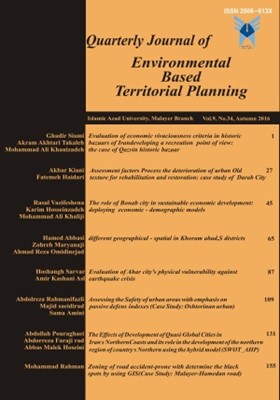Evaluation of economic vivaciousness criteria in historic bazaars of Iran: developing a recreation point of view: the case of Qazvin historic bazaar
Subject Areas :Ghadir Siami 1 , Akram Akhtari Takaleh 2 , Mohammad Ali Khanizadeh 3
1 - Ph.D., Assistant professor, International University of Imam Reza (AS), Mashhad, Iran.
2 - M.Sc., Urban Planning, School of Art and Architecture, International University of Imam Reza (AS), Mashhad, Iran.
3 - M.Sc., Urban Planning, School of Art and Architecture, International University of Imam Reza (AS), Mashhad, Iran.
Keywords: recreation, historic texture, renew, Qazvin’s bazaar, economic vivaciousness,
Abstract :
Focusing on eroded and historic textures and trying to provide remedy for their instability is becoming a serious and pivoted subject for the ancient bazars of Iran ,therefore, relevant organizations began to order and recreate such textures, and felt the necessity for intervention in line with preserving this textures in different time series. Coherence and concordance between parts of space and their acts in historic textures of Iran has caused the fact that urban spaces come in to existence according to skeleton and spatial structure of texture in Iran. At a time, Qazvin s bazaar has been a head quarter of wealth and power in Qazvin and even in its regional needs. While in present condition it has lost its operation with respect to its assumed economic profit. This essay is trying to reach on Qazvin’s bazaar vivaciousness with recreation point of view. Research method in this essay is analytic-descriptive, and tools of collecting data include library methods, questionnaire and field methods. Sample selection is simple random and target community is traders, experts and applicants. SPSS and Expert Choice are used in this investigation and the data is analyzed via AHP and SWOT. Findings of this survey show that the most important reasons for non-existence of economic vivaciousness in bazaar is proved to be the lack of recreation and improvement in form and construction of bazaar with weight of 4. 4 and also weak cultural role of bazaar with weight of 4. 3, and bazaar can reach economic vivaciousness when it can be considered via physical, cultural-social, and applied recreation. Findings of this essay show that Qazvin’s bazaar needs operational recreation to reach on economic vivaciousness.
1- ارجمندنیا، ا. 1382. احیای اقتصادی بافت قدیم شهری – دستاوردهای دو تجربه. فصلنامه هفت شهر. سال چهارم. شماره چهاردهم.
2- بیگلری.، ا. 1355. بازارهای ایرانی. ،مجلۀ هنر و مردم. شمارۀ 162.
3- پاکزاد.، ج. 1382. معیارهای کیفی سنجش فضا، فصلنامه آبادی، شماره 39.
4- حبیبی،. س. م. مقصودی،. م. 1381. مرمت شهری. انتشارات دانشگاه تهران. تهران.
5- ...........، ک. 1386. بهسازی و نوسازی بافتهای کهن شهری. انتخاب، تهران.
6- رجبی.، آ. 1386. ریخت شناسی بازار. انتشارات آگاه، تهران.
7- ........... .1387. ریخت شناسی بازار. انتشارات آگاه. تهران.
8- رضوانی، س. 1367. بینش اسلامی و جغرافیای شهری. مجله تحقیقات جغرافیایی. شماره 4.
9- رهبان.، صلاح الدین. 1388. تحلیل اجتماعی-اقتصادی بافتهای فرسوده جهت ساماندهی آنها (نمونه مورد مطالعه سقز). پایان نامه کارشناسی ارشد برنامه ریزی شهری، دانشگاه پیام نور ساری. 249.
10- سرایی، م. ح. 1389. بازار یزد. پیدایش، پویش و کارکردهای آن. پایان نامه کارشناسی ارشد طراحی شهری. دانشگاه شهید بهشتی. 281.
11- سجاد زاده، ح.، زلفی گل، س. 1394. طراحی شهری در بازآفرینی محلات سنتی با رویکرد محرک توسعه نمونه موردی: محله کلپا همدان. فصلنامه آمایش محیط، شماره 31. صص 171-147.
12- سلطان زاده.، ح. 1374. نائین شهر هزاره های تاریخ. دفتر پژوهش های فرهنگی تهران.
13- شیخ زین الدین، ح. 1381. محورهای پژوهش بازار با رویکرد به آینده. مجله هفت شهر. شماره 11.
14- طرح جامع شهر در طرح احیاء و مرمت بازار قزوین، 1379.
15- عندلیب،ع. ر.، بیات، ا.، رسولی ،ل. 1392. مقایسه و تطبیق بازآفرینی بافت های فرسوده شهری بلوک خیام تهران (ایران) و پروژه لیورپول (بریتانیا). فصلنامه آمایش و محیط 6(23). 104-79.
16- عسکری خانقاه.، ا. 1380. تأملی در مردم شناسی فرهنگی بازار و مسکن شهر قزوین (با توجه به مرمت بناهای قدیمی). نامه علوم اجتماعی، شماره 17.
17- کیانی، ا.، سالاری سردری، ف.، افراسیابی راد. 1388. بررسی هویت بخشی شهر فیروز آباد در بهسازی و نوسازی بافت شهر گور با استفاده از تکنیک SWOT. فصلنامه آمایش محیط، صص 138-120.
18- لنارد کروهرست، س. لنارد کروهرست،. ه. 1377. طراحی فضای شهری و زندگی اجتماعی. معماری و شهرسازی. شماره 44 و 45. تهران.
19- معتضد.، خ. 1366. حاج امین الضراب و تاریخ تجارب و سرمایه گذاری صنعتی در ایران. چاپ اول. بهمن.
20- محمد مرادی،. ا. 1379. طرح جامع شهر در طرح احیاء و مرمت بازار قزوین ( گزارش مرحله اول).
21- مرادی.، م. 1384. مرمت و احیای ساختمانهای قدیمی به عنوان گامی درجهت حفاظت و مرمت شهرتاریخی. مجله بین المللی علوم مهندسی دانشگاه علم وصنعت ایران، تهران.
22- موحدی.، ع. 1389. احیای بازارهای تاریخی، هویت بخشی به فضای کالبدی شهر: مطالعه موردی بازار شهر زواره. همایش علمی منطقه ای معماری کویر. دانشگاه آزاد اسلامی واحد اردستان.
23- ودیعی.، ک. 1351. بازار در بافت نوین شهری. مجلۀ یغما. جلد 25. شمارۀ 283. ص 19-9.
24- Bobek, H. 1959. Die Hauptstufen der Gesellschafts-und Wirtschaftsentfal-tung, in Geographischer Sicht.
25- Batey, P. 2000. Urban Regeneration in Britain: Progress. Principles and Prospects. International Symposium on Regeneration of City Down Town.
26- English Heritage .2008. Conservation Prin ciples: Policies and Guidance for the Sustainable Management of the Historic Environment. English Heritage.London.
27- Lapidus, Ira Marvin. 1967. Muslim Cities in the Later Middle Ages. Cambridge/ Mass.
28- Landry, Charles. 2000. Urban Vitality: A New Source of Urban Competitiveness. Prince Claus Fund Journal. ARCHIS issue .Urban Vitality/Urban Heroes.
29- Lang, T. 2005. Insights in the British Debate about Urban Decline and Urban Regeneration. Working Paper. Erkner. Leibniz-Institute for Regional Development and Structural Planning.
30- Noon, A. & et al .2000. Economic Regeneration and Funding, in: Roberts. Peter. Sykes. Hugh (eds.): Urban Regeneration. A Handbook. London.
31- Rada, Deborah.1999. Transformational Leadership and Urban Renewal. Journal of leadership studies. center for graduate studies.
32- Urban Task Force.1990. Toward an Urban Renaissance. A Report of Urban Task Force 1990.UK.
_||_


